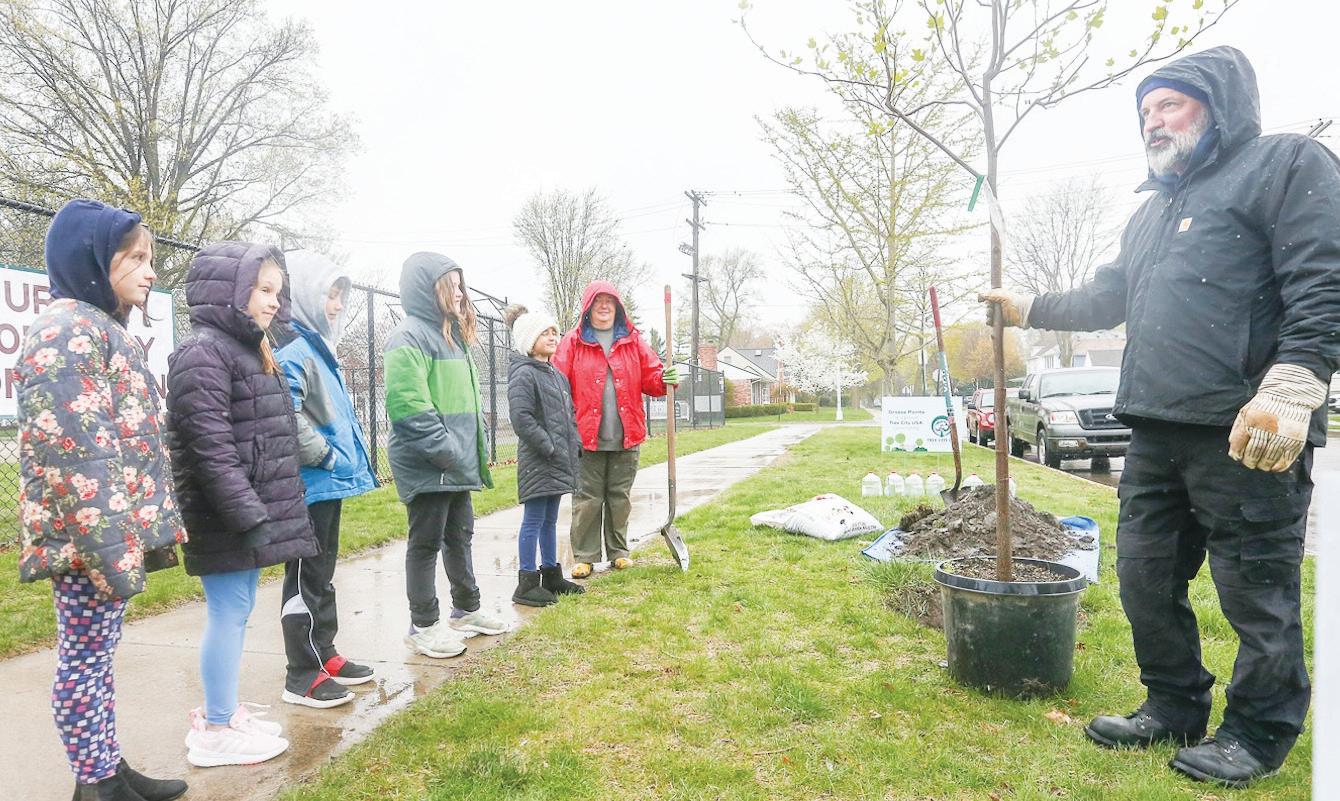




BY K. MICHELLE MORAN kmoran@candgnews.com
GROSSE POINTE PARK — Driving through the Grosse Pointes, some people notice the stately homes, the lush gardens or the lakefront vistas. What caught Brian Colter’s eye was the trees.
“Brian knew the trees,” said Colter’s longtime partner, Grosse Pointe Park Beautification Commission Chair Lisa Kyle. “If we were going to pick up a carryout, we’d be driving through the Grosse Pointes and he’d say, ‘Look at that tree — it’s doing great now.’ It’s because he actually really cared about that tree.”
As Grosse Pointe Park’s urban forester for the last 30 years, and concurrently the urban forester for Grosse Pointe City and Grosse Pointe Farms since 2023, Colter selected, monitored, cared for and often planted many of the city-owned trees residents and visitors enjoy today. It was never just a job for him.
Colter, 57, died March 15 at home in Grosse Pointe Park. For a man who just a day earlier had been attending tree board meetings and making plans for future plantings and projects, it was a shocking loss. Even though Colter had been dealing with health problems in recent years, he remained a tireless advocate for trees, as well as a beloved father, brother and friend.
On Arbor Day — April 25 — family, friends




‘The animals need you’
BY ANDY KOZLOWSKI akozlowski@candgnews.com
STERLING HEIGHTS — For more than 10 years, Kim Walton served as the animal control officer for Sterling Heights, Warren and Eastpointe. She enforced animal welfare laws, taught the public about pet safety and found homes for strays at the shelter.
She retired in 2023. Since then, she’s continued to put her wildlife expertise to good use. Whether it’s squirrels in the attic, birds in the chimney, or the live trap removal of groundhogs, skunks and rats causing mischief in the yard, her goal is to relocate each animal without harming it, and then ensure they thrive in their new environment.
“I always enjoyed the wildlife calls at animal control — things like a squirrel running around someone’s house, a raccoon in a fireplace. I was always fascinated by nondomestic animals,” Walton said. “I loved what I did as an animal control officer and knew I was making a difference. But I think it took a toll on me mentally over the years. I was very passionate and had a hard time turning it off. I thought about work constantly: the shelter animals that needed to be placed, the court hearings, the abuse cases.”
In 2021, two years before she retired, she started to refocus. She came up with the concept of Compassionate Critter Removal, a venture she found invigorating.
“I wanted to provide a humane option for critter removal,” Walton said.
She had already seen so much as an animal control officer. In her
previous role, she would regularly receive calls from distressed residents in each town.
“They’d range from injured wildlife to found baby squirrels, raccoons, rabbits, groundhogs — sometimes in people’s homes,” Walton said. “That gave me a chance to familiarize myself with various types of wildlife, to learn their behaviors. I was also able to form contacts with local wildlife rehabbers that I still use today.
“What you see really depends on the time of year. Each species has a baby season, and that’s when problems arise,” she said. “For example, raccoons typically start having babies in March. Around this time, they’re desperate to find nesting places, and the most common places they get into are uncapped chimneys, fireplaces and attics. We also get them under homes, down in crawl spaces. It’s common for them to go undetected prior to the babies making noise.”
To that end, many issues can be avoided with a bit of due diligence.
“I often tell people to do a monthly inspection of their home,” Walton said. “Always check for missing or compromised chimney caps, missing soffit pieces, falling shingles, paw prints on down spouts and digging near the house. Always cut back any trees touching the roof — once critters have a segue to the roof, trouble starts.”
Sometimes the calls are especially urgent.
“I get a few ‘911’ calls, like one last year in Grosse Pointe where a man woke up with a raccoon in his bed. He was able to confine it in a closet until we could arrive,” Walton said. “We also get situations where animals are injured, sick or stuck in something like a

fence or car engine.
“Being able to confine the animal is always best, but if you’re not able to do that or aren’t comfortable with that, keep an eye on it — that way when someone gets there, they can locate it,” Walton said. “It’s important to remember these are wild animals that can carry disease. But they’re usually just as scared as us and want nothing to do with us.”
She described Compassionate Critter Removal as something of an “odd niche.”
“I oftentimes feel guilty for having to relocate the animals. I try and combat that by relocating them to the most ideal area for each species. We relocate them to properties where we drop off food multiple times a week. This provides a good source while they settle into a new area,” Walton said.
“The cages are wrapped in tarps to help the animal feel safe and less exposed. This also helps shelter them from the elements,” she said. “I use specific bait for each species. If it’s hot, we have water crocs that get attached to cages and provide hydrating bait. If it’s cold, I put a towel in the traps so the animals can warm up.
“But I still feel guilty having to relocate them,” she said. “The reality is us humans are taking away all their homes and land. On top of that, you have people ground feeding them, which draws unwanted critters into residential spaces, and that creates an overabundance of animals. I just have to remind myself that I’m doing necessary work. The goal is to remove the animals as humanely and compassionately as possible.”
Among the many kindred spirits Walton has worked with over the years is Julie Tirony, cofounder of the no-kill rescue Animal House of South East Michigan.
“What I admired most about Kim as an animal control officer is how for her, it


wasn’t just a job; she made a point of networking to get animals out of the holding space they had in Sterling Heights. The shelter there is very small, with only a certain amount of time before they’re transferred to the county where they might be put down,” Tirony said. “She compiled a list of rescues over the years and would ‘spread the love,’ as I called it — going down the line, asking if a rescue can take two cats here or there, and if they couldn’t, maybe the next rescue could. She’d do this to save them all.
“Not all animal control officers are like that. Even the ones who care get compassion
fatigue, where they feel exhausted from caring so much, and they might not put in the same effort,” she said. “It’s not an easy way to do the job. But Kim believes in doing whatever she can to help.”
Walton said those interested in a career helping animals should follow their passion.
“I think there’s a growing interest — people see animals very differently than 20, 30 years ago. They see their emotions, and they have empathy,” Walton said. “So whether you want to advocate for them in animal control, help at a rescue or become a veterinarian, the animals need you.”
















ested in purchasing the property.
The protest took place in front of Gonzo!! Art Studio, whose owner, Edward Stross, filed a claim of appeal in Macomb County Circuit Court in March to halt the Sheetz location. The protesters gathered at the corner of Utica Road and Gratiot Avenue, then spread to Gratiot’s median. DJ Mike Logic played a variety of music ranging from Motown to classic rock to hip-hop. A steady stream of car horns sounded out in support of the protest.
Prior to the protest, Stross said there was an unnamed party interested in Sacred Heart. Pastor Steve Upshur, from Peacemakers International, which is located in Detroit, announced his intention to acquire the property. He said he’d like to see the former church become a mixed use building that would provide help to homeless people in the area. He compared the struggle to preserve the property to the Biblical David and Goliath story.
“I believe God wants that building for himself,” Upshur said.
Upshur delivered a prayer for the building to be preserved. Though he said he had nothing against Sheetz, he said he was in opposition to forces that wanted to destroy the church. He hoped God would turn the hearts of those in positions of power.
“You see the hearts of the people; they want to do what’s right,” he said. “This is not about money. … Lord I know you’re tired of money and corruption and all the craziness that goes on, on all kinds of arenas of the planet. But we’re at this intersection of Utica and Gratiot right now and we pray for that building over there in the name of Jesus.”
DJ Mike Logic stepped from behind the booth to speak.
“Go to your City Council meetings,” he said. “Talk to your representative. Even if you didn’t support them, they have to support you. That is their job.”
Kathy Bidoul, who had previously worked with a homeless shelter in Mio called Lydia’s Gate, spoke to the stigma homeless people face and supported the church and surrounding buildings to assist people in desperate situations.
“There’s so much possibility there; none of that should be torn down” Bidoul said.
The Rev. Gary Geldhof, a Roseville resident, said he hoped to see a church or a center for those in need occupy the former Sacred Heart building.
“They can do better with something
else other than a gas station,” Geldhof said. “You’ve got one, two, three right here. Three gas stations, you don’t need any more.”
Roseville resident Crystal Hart came to oppose the new Sheetz location.
“I’m definitely worried about the church because it’s a landmark that we grew up with here in the city of Roseville,” Hart said.
Hart is also concerned about the increased traffic to the area.
“We already get so many accidents on this strip,” Hart said.
Roseville resident Cindy Schafer, with agreement from Hart, said that local businesses will suffer from the new Sheetz moving in. Schafer was baptized at Sacred Heart 75 years ago. She went to the church and her husband attended the school on the property. She was concerned about the fate of the nearby cemetery.
“I have a lot of plots there,” Schafer said. “I’m so afraid of what’s going to happen to the cemetery if the church goes down.”
Sexton confirmed that the cemetery would remain.
“The cemetery is absolutely not part of the Sheetz development,” Sexton said. “The cemetery is going to remain as is and that part of the property is not part of this deal.”
Gloria Gorko, who now lives in Eastpointe, attended Sacred Heart’s school from first grade to 12th grade. She said that the church’s rectory would make for an ideal bed and breakfast location.
On the other side of the street, a smaller gathering took place, welcoming Sheetz to the neighborhood. Those in favor of the development stood next to a banner that read, “Welcome Sheetz.”
Roseville resident Mike Bennett, who attended Sacred Heart, is in favor of Sheetz moving in.
“I went here, went to everything when they were having fundraisers and everything else,” Bennett said. “Now it’s an empty building. They found needles inside. It’s falling apart.”
Bennett said the criticism of city officials was misplaced, adding that “you have to have new business or the city dies.”
“The building’s gone,” he said. “I love the building, but it’s got to go for progress. They’ve had eight years to come up with money their own way and they didn’t come up with anything.”
Earl Louks, a former Roseville reserve police officer, said the church building had black mold throughout it.











































